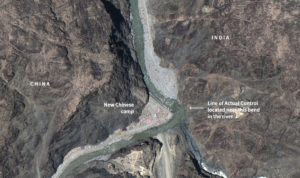America can learn from China’s amazing high-speed rail network
China is already halfway to a high-speed rail future, where taking the train is the easy option and flying is the second choice. The most convenient way to travel between Beijing and Shanghai is by high-speed train, and that statement is true for a growing number of routes across China. China already has 18,000 miles of high speed rail, with plans to extend to 24,000 miles by 2025.

U.S. congresswoman Alexandria Ocasio-Cortez and Senator Ed Markey in February announced a pair of resolutions called the Green New Deal, which include a proposal to “build out high-speed rail at a scale where air travel stops becoming necessary.” That is a tall order in a country where the president and a significant proportion of the ruling class are climate change denialists, in cahoots with the fossil fuel industries.
But China is already halfway to a high-speed rail future, where taking the train is the easy option and flying is the second choice. The most convenient way to travel between Beijing and Shanghai is by high-speed train, and that statement is true for a growing number of routes across China, the land area of which is about as large as the U.S. In the coming years, we may very well see high-speed railways built by China in other countries, especially those within the Belt and Road initiative, the gargantuan infrastructure and commerce network that is a key project of General Secretary of the Communist Party of China and President Xí Jìnpíng 习近平.
China’s high-speed rail network in 2019
Trains on China’s passenger-dedicated high-speed railways operate at speeds of 250 to 350 kilometers per hour (155 to 217 miles per hour). The network comprises 18,000 miles of railways, with plans to extend to 24,000 miles by 2025.
As you can see from the map below, if transplanted to the United States, China’s high-speed railways would make the entire East Coast and much of the Midwest accessible by high-speed train, with lines stretching into Washington State and Texas. But even this map overlay does not show the true value of the rail network to China’s passengers and economy: Roughly 80 percent of China’s population lives in the eastern part of the country, where the railways are concentrated.


The Beijing-Shanghai route is currently around $70 to $300, depending on seat class — second, first, and, most expensively, “business.” Shorter routes can cost just over $10. Trains making overnight journeys have sleeper compartments. The compartments are new, quiet, and comfortable. Some stations are testing facial recognition systems to replace tickets.
How did China get here? A timeline of construction
China already had an extensive conventional railway network, one of the few infrastructure achievements of the Mao era.
The Ministry of Railways began planning China’s high-speed rail network in the 1990s. The high-speed railway network, trains, and services are owned and operated by the China Railway Corporation (CRC). Trains have always been important in communist China — CRC is a powerful state-owned organization that, until recently, had its own police force, prosecutors office, and court system.
Aside from the 18,000 miles of high-speed tracks, CRC also operates roughly 60,000 miles of regular-speed passenger and cargo railways.
Although some key technology was acquired in deals with foreign partners, CRC now makes all of its trains and railways using its own intellectual property. The company is also open for business in any country that has the money — or willingness to go into debt — to finance construction.
2004 Shanghai Pudong Airport Maglev
Construction began in 2001 on the Shanghai Maglev or Shanghai Transrapid (上海磁浮示范运营线 shànghǎi cífú shìfàn yùnyíng xiàn) — a magnetic levitation train that takes passengers part of the way (alas!) into the city at speeds of 268 miles per hour. At a cost of around $1.2 billion, the line opened in 2004 and has never made a profit.
The high cost and the reluctance of German companies Siemens and ThyssenKrupp to share key technologies that power the maglev (for magnetic levitation) led China to opt for the slower “conventional” electric high-speed technology that CRC mastered with some help from its early partners.
2008 Beijing-Tianjin
China’s first conventional high-speed route opened in August 2008 to coincide with the Olympic Games, connecting host city Beijing with nearby Tianjin, a half-hour journey at 350 kilometers per hour (217 miles per hour).
2012 Beijing-Shanghai
This is probably the busiest route on the network, transporting about 180 million passengers a year. The 800-mile journey — about the distance between New York and Nashville — takes under five hours.
2013 Shanghai-Wuhan-Chengdu
The first part of this major artery opened in 2008, loosely tracking the path of the Yangtze River. The three major cities were connected by 2013, allowing a Shanghainese person to set out in the morning for the spicy food capital of Chengdu — 1,200 miles away — and have lunch there after a five-hour journey.
2013 Shanghai-Hangzhou-Fuzhou-Shenzhen
This route connects four of the economic dynamos of the east coast. Hangzhou is Alibaba’s home city. Shenzhen is the tech hub next to Hong Kong, home to Tencent. Fuzhou is the provincial capital of prosperous Fujian, and is connected by high-speed train to Xiamen, one of China’s most pleasant cities on the mainland side of the Taiwan Strait.
2014 Lanzhou-Urumqi
This line connects the capital of Gansu Province with the capital of Xinjiang, the “autonomous region” most famous in recent years for its oppressive internment camp system.
2016 Shanghai-Kunming
Connecting the capital of tourist-friendly Yunnan Province with Shanghai, this route is known for beautiful mountain scenery.
2018 Beijing-Hong Kong
This route takes around 10 hours and terminates at a railway station in Kowloon that is operated by the mainland Chinese authorities and under Chinese legal jurisdiction. Many Hongkongers are not comfortable with this.
2019 Beijing-Harbin
This line links the capital with the northeast’s industrial and commercial hub, a seven-hour journey. A branch connects to the port city of Dalian.
The future: Chinese maglev, and high-speed routes to Lhasa and Kashgar
CRC announced in January 2019 that it planned to open 4,225 miles of new high-speed rail in 2019. Future plans include connecting Lhasa to Sichuan, and extending the Xinjiang part of the network to Kashgar, the besieged Uyghur oasis town in the far west of the country.
In May, CRC unveiled a prototype of a high-speed train using China-developed maglev technology that is designed to run at 370 miles per hour.
Safety record and the Wenzhou train crash scandal
Are Chinese high-speed trains safe? They seem to be very safe: There has been only one reported accident that led to fatalities in the network’s history. However, the circumstances of that accident have led to persistent doubts among the public.
On July 23, 2011, a high-speed train from Hangzhou to Fuzhou crashed near the city of Wenzhou (famous for its entrepreneurs), killing 40 people and injuring more than 100. The authorities bungled the cleanup, and at various times told implausible stories about the cause and progress of disaster relief work, leading to widespread criticism online.
It did not help that earlier in the year, the government had sacked Liú Zhìjūn 刘志军, the Minister of Railways, who oversees CRC, and sentenced him to death (commuted to life) for corruption. Among his crimes, it was reported that he had kept 18 mistresses. Online critics expressed fears that under Liu, corrupt officials at CRC had been using inferior materials to build the high-speed rail network while funding their own decadent lifestyles.
Since then, however, a zero-accident record for the better part of a decade has reassured most Chinese passengers that the trains are safe.












